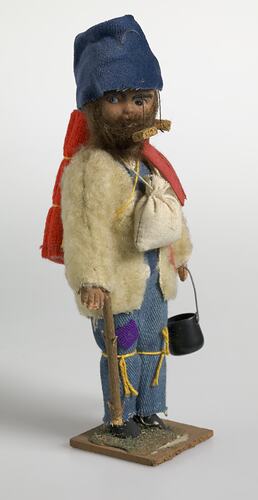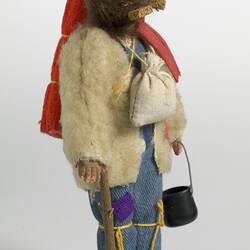Summary
Alternative Name(s): Swaggie, Swagman
National doll produced to represent an Australian man. Dolls are among the most universal toys found throughout the world and through history. Ornamental dolls can also be used to represent aspects of cultural traditions, such as dress. This doll has been dressed to represent a Swagman, who were a common feature in Australian rural life during the gold rush, the 1860 and1890 depressions and the Great depression of the 1930s.
This doll comes from a collection of approximately 150 dolls in an array of national and regional costumes which were collected by Edna Setford from 1964-1988. Her husband Clifford continued the collection until his death in 1997. The collection is the work of both Edna and Clifford as well as many friends and family who brought dolls home to Edna as gifts from overseas trips. The final doll arrived two days after Clifford's death.
These dolls were purchased as souvenirs of particular countries and like many mass produced souvenirs they are often not accurate representations of a particular country or region, and may actually better reflect neighbouring counties or regions. This occurs because costumes are often stylised and simplified resulting dolls wearing generic costume elements which are common to many countries/regions. Often the fabrics and decorations used are selected to make the dolls cheap and easy to manufacture and aesthetically pleasing. This can result in the fabrics, colours and decorations of the doll's clothing having little or no reflection of the costume associated with a particular country or region they are meant to be representative of.
Physical Description
Male doll with a thick brown beard, dressed in patched pants, tied with string, a blue shirt, sheep skin jacket and blue hat with pieces of cork tied on with long strings. The doll also has a red swag tied to his back, a pouch around his neck, a billy in one hand a a stick in the other.
More Information
-
Collecting Areas
-
Acquisition Information
Donation from Eril Wangerek, 01 Sep 1997
-
User
Mr & Mrs Edna & Clifford Setford, Victoria, Australia, circa 1964-1997
Owners of this doll collection which was acquired during this period. -
Place Depicted
Australia
This doll is intended to represent an Australian Swagman -
Classification
-
Category
-
Discipline
-
Type of item
-
Dimensions
143 mm (Width), 255 mm (Height)
-
Keywords
Keepsakes, National Costumes, Souvenirs, Travel, Working Life



